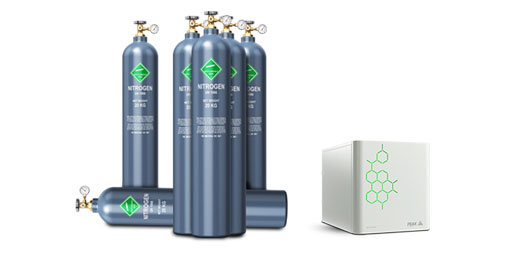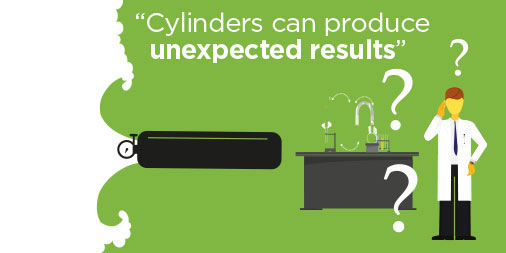Gas Safety in the Laboratory
Modern laboratories use a number of gases as part of their daily operations. This blog details two of the most common methods of laboratory gas supply, and their associated safety risks and benefits.
A number of gases are used in laboratories to support various applications such as Chromatography (GC and LC-MS) Spectroscopy, ELSD and Sample Preparation, to name just a few. Helium, hydrogen and nitrogen are some of the most common gases used by labs for these applications.
Gas is typically supplied to laboratories in one of 3 ways:
• Dewar
• Cylinders
• Gas generator

Traditionally cylinders have been the most common method of gas supply and they are still widely used in labs around the world. If you use cylinders in your lab you should follow the safety tips below.
1. Cylinders should be stored in a cool, dry place away from heat. Flammable cylinders should be stored separately from oxygen or hydrogen cylinders.
2. Be careful when moving the cylinder and removing the cylinder cap. The gas inside is highly pressurized.
3. Cylinders in use should be checked once every three years. The cylinders with corrosive gases should be inspected every two years and unqualified cylinders should not be used.
4. Hydrogen cylinders should be placed in a dedicated place away from the laboratory, connected with copper/stainless steel piping into the laboratory and secured to prevent tampering. Pipework should be regularly leak-checked to prevent large leaks of hydrogen.
5. It is best practice not to use the entire contents of the gas cylinder. Normally the last 10% is not used, since this can contain moisture, hydrocarbons and other impurities that can cause contamination of instruments. Pressure within the cylinder prevents air entering the cylinder so it is advisable to ensure the residual pressure never drops below 0.5MP (70 psi).
6. When using cylinder gas, a 2-stage regulator with a pressure relief valve should be used. Flammable gases will require a regulator with left-hand thread. It is important to slowly open and close the pressure regulator and valve. First the cylinder pressure should be checked and then supply to the application should be carefully regulated until the recommended pressure of gas is supplied.
7. When using a high-pressure cylinder, the operator should not stand in a position in front of the cylinder connection to avoid potential injury. Once connected, you should regularly check for leaks and pay attention to pressure gauge readings.
8. Hydrogen cylinders should be equipped with special regulators, and contact with oil is strictly prohibited. The operator should not wear certain items of clothing around these cylinders such as materials which can become static and cause a spark, as hydrogen is extremely flammable. For all flammable gas and combustion gas cylinders, the storage distance from an open flame should be greater than ten meters. If this is not possible, use isolation and other safety measures.
Following these tips should ensure your use of gas cylinders is as safe as can be. However, gas cylinders are inherently dangerous and introduce many risks into the laboratory environment. These risks should be carefully considered when choosing or reviewing a laboratory’s gas supply.
Gas Cylinder Safety Risks
Simply handling gas cylinders is a risky business. Laboratory staff are at risk of injury every time they need to move a gas cylinder and this need can arise often, sometimes every week or every few days, depending on a lab’s gas usage. Gas cylinders are large and heavy so anyone who is required to move them should be trained to do this safely, to prevent the common injuries associated with moving heavy goods such as back or muscle strain injuries. An appropriate cylinder trolley should always be used when moving gas cylinders. If a gas cylinder is dropped or damaged when being moved, it could injure the person moving it and it could also pose a significant threat to anyone in the vicinity. For example, if a hydrogen cylinder is damaged it could cause an explosion, or even become a rocket, dangerous enough to be propelled through thick concrete.

With some gas cylinders the danger can be less obvious. For example, if a nitrogen gas cylinder were to develop a leak, this could result in asphyxiation. A typical nitrogen cylinder contains around 9000 litres of nitrogen gas at high pressure. This means that any leak could quickly displace oxygen in the surrounding atmosphere. Less than 18% oxygen in air will impair cognitive function and less than 6% will cause immediate fainting and brain damage.
Safety Benefits of using a Gas Generator
Fortunately, all of these dangers can be averted by using a gas generator instead of gas cylinders.
Gas generators generate gas on demand, as it is required by a laboratory instrument. This means that they only store a minimal amount of gas at any one time. A hydrogen generator does not store enough gas to reach hydrogen’s lower explosive level (LEL), which is 4.1% in air. In a typical laboratory it would take around 2050 litres of hydrogen to reach the lower explosive level. With a hydrogen cylinder which typically contains 9000 litres of hydrogen, a leak could cause the LEL to be reached in minutes. In contrast, a PEAK Scientific hydrogen gas generator only generates 500cc of hydrogen per minute, meaning it would take almost 3 days for the LEL of hydrogen to be reached in the same laboratory, and only if that laboratory was hermetically sealed.
This outcome is extremely unlikely with a PEAK Scientific hydrogen generator as all PEAK hydrogen generators have the following safety features:
• Internal leak check on start up
• External leak detection
• Pressure monitoring to prevent leaks and pressure build up
• Automatic cell shutdown at high pressure
• Audible/visual alarms
Gas generators also have none of the associated risks of moving or changing cylinders. This is because once a gas generator is in place, there is no need to move it. With regular scheduled maintenance, a gas generator will produce a constant gas supply, unlike gas cylinders which run out and need to be changed.
If you are considering upgrading your gas supply from cylinders to a gas generator to improve safety in your laboratory, you will be pleased to know that, as well as being much safer than gas cylinders, gas generators are also more reliable and economical. Gas generators produce a consistent purity of gas, unlike gas cylinders which can have inconsistent purity not only from cylinder to cylinder but even from first to last use of a single cylinder. This is why it is recommended to change a cylinder once 90% of its capacity has been used, as the remaining 10% can contain elevated levels of moisture and hydrocarbons which can affect instruments and analysis.
Beyond the obvious safety benefits of a gas generator, it is also possible to see a return on your investment within 18 months which makes a generator a much more economical solution than ongoing rental of gas cylinders. The gases contained in cylinders increase in price year after year, as do their delivery and rental costs. Gas cylinders can also run out at inconvenient times, and they result in frequent instrument downtime while they are changed over.
Not only are Gas generators a safer solution for laboratory gas supply than gas cylinders, as they present none of the risks associated with handling gas cylinders and present significantly less risk of explosion or asphyxiation, it is also clear that gas generators are a more economical and reliable laboratory gas supply solution.
To eliminate all of the risks and inconveniences that are part and parcel of using gas cylinders by switching to a gas generator, contact PEAK Scientific or visit our website to learn more.
Found this article useful? You may also be interested in:
Considering a hydrogen or nitrogen generator? Rely on PEAK to provide exactly what you need
Alternative carrier gas for GC and GC-MS